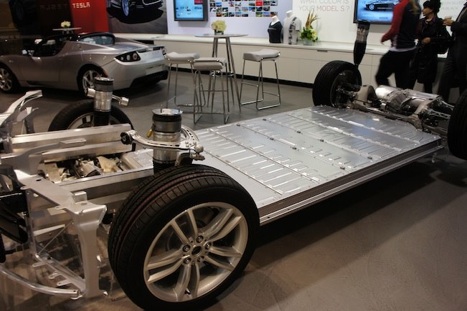Tesla Motors, Batteries, and the Truth



Tesla Motors, Batteries, and the Truth

HAVE COMMENTS OR QUESTIONS? WE LOOK FORWARD TO HEARING FROM YOU.
Index to News Articles
Feb 25, 2012 - Tesla Motors, Batteries, and the Truth
Feb 10, 2012 - The Model X Reveal Experience - Part 1
Feb 08, 2012 - EVs are the Future: Believe the Hype!
Jan 23, 2012 - Cell Phones and Cars in an Alternate Universe
Jan 15, 2012 - Model X: What to Expect on Feb 9, 2012
Jan 08, 2012 - Model S Signature Cars Sold Out in the USA!
Jan 05, 2012 - New Car Value Index Reveals Best Deals
Dec 21, 2011 - The Signature Model S has a $3,550 Premium
Dec 20, 2011 - Model S Options & Pricing Observations
Dec 10, 2011 - Model S Options may be disclosed on Dec 15?
Nov 28, 2011 - Tesla Reinvents the Car Buying Experience
Tesla Motors, Batteries, and the Truth
Saturday, Feb 25, 2012
by Max Mindel
With every revolution, there is change. After all, one of the definitions of "revolution" is exactly that, "change", or to be more precise, per dictionary.com, "a sudden, complete or marked change in something." As we embark on a revolution in personal transportation, we are learning about these changes as they surface. We already know that we won't be able to fully refuel our EV's within minutes like we do with our gasoline-fueled vehicles, but in exchange, we'll have the benefit of waking up to a fully-fueled(charged) vehicle that was fueled(charged) from the comfort of our homes while we sleep and in turn reduce our transportation costs (see Teslanomics). To some, at first, it will feel like something has been lost, but within time, as we adapt to this change, the whole notion of having to interrupt any trip to refuel will suddenly feel like a burden and it will ultimately evolve into a story that we, as grandparents, will tell to our children. This feeling will surely be even more widespread as batteries capacities evolve and as such vehicle ranges increase. The range on most gasoline-fueled vehicles is about 300 miles, so as we get beyond that with electric vehicles, the range of our “by then” former gasoline-fueled vehicles will feel somewhat limiting. Additionally, we'll be able to start turning around the damage we've already made to our planet, especially as power grids continue to get cleaner and greener.
On February 22, from an article published online at theunderstatement.com, we learned that just as our current gasoline-based car technology requires regular fluid maintenance from a lack of which imposes a risk of damage to the motor, an electric vehicle, and in this case, specifically a Tesla Roadster, requires that the car not be allowed to completely de-charge, otherwise it can lead to irreversible battery damage, or what is known as a "bricked" battery. In this article, it is revealed how a gentleman who got busy with a home remodel, left his Tesla Roadster in storage, unplugged for a full two months. When he went to retrieve his car, he couldn't start it because the battery was not only dead, it would no longer take a charge. Keeping your car plugged in is one of the "maintenance" requirements of an electric car which Tesla Motors even makes sure you know of by having you sign a waiver acknowledging that. Let me explain why.
Lithium-ion batteries work well within a specific temperature range, and as such, suffer declining performance below 14°F/-10°C and whose properties begin to deteriorate at over 140°F/60°C. Incidentally, it makes no difference whether these lithium-ion cells are in a car or in a notebook computer. This is just a matter of physics, chemistry, and the way lithium-ion battery technology works. The average temperature over a battery's lifetime will affect the calendar life of your battery, that is, how long it will last. Batteries last longer when they are kept cool. In fact they would last longer if they spent their entire lives in a refrigerator. So even when a Tesla Roadster is off and not in use, it is actively using power to maintain the temperature of the batteries at an optimal range which happen to live in a sophisticated liquid cooling system designed to keep the battery temperature below 95°F/35°C, with an average lifetime temperature of 77°F/25°F. It is analogous to how our bodies expend energy to maintain our bodily temperature at around 98.6 degrees Fahrenheit, even when our bodies are at rest. If you drive far in a Tesla Roadster and deplete over 95% of your Tesla's battery capacity, the car will begin to warn you with both visible and audible warnings. If you continue to ignore these warnings, they will both persist and continue to warn you at an ever-more increasing rate. Tesla Motors went as far in their design in enabling a feature that notifies them of this impending battery damage so that they can phone you to warn you. (What other company does this for their customers?) The reason for this is that the remaining amount of power may be inadequate to maintain the ideal temperature of your Tesla's array of battery cells. So, you basically, at that point, you just need to plug it in. You could say that this requires a learning curve. However, it is really no different than what we've already learned to do, and that is, to stop off at a gas station to refuel if you car is almost out of gasoline. In this case it's just making sure that you plug in your car every night just as you already do with your cell phone or perhaps another electronic gadget. Fortunately, we happen to be a pretty smart species, otherwise, I suppose, we'd have thousands of cars stuck on the highway every day from people who ignored the low fuel warning on their gasoline-fueled cars. The fact that this doesn't happen regularly, gives me faith in anticipating that people will in fact adapt and incidents like the one described in the theunderstament.com article will be extremely rare or almost nonexistent. Let's face it, if you let your car run out of gas, you were being neglectful, and not charging your EV is an action that is no different.
What's different however, is that with the Tesla Roadster, this negligence will cost you a whopping $40,000 US. That happens to be the current cost of its 240-mile battery pack. That's a huge expense to burden for being careless. The cost to replace the battery on the soon-to-be-released Model S has not been disclosed. However, if you do that math, you can almost speculate what the cost is. The Model S with 160 mile/40 kWh battery is included in the basic cost of $57,400. However, if you upgrade to the 230 mile/60 KwH battery, the cost is an additional $10,000. Upgrading to the 300 mile/85 kWh battery costs an additional $20,000 from the $57,400 base price. Thus, it seems that every 20 kWh of battery capacity costs about $10k. If we extrapolate that, replacing the battery on each version of the cars is theoretically as follows:
160 mile/40 kWh = $20,000
230 mile/60 kWh = $30,000
300 mile/85 kWh = $40,000-$45,000
Fortunately, however, as Tesla Motors continues their R&D, the Tesla Model S technology will be better. The Roadster takes a full 2 months to discharge if left unplugged with a 50% charge remaining. For the Model S, this would however, take 6 times as long, an whole year! This is because unlike the Roadster, the Model S is able to protect itself while not in use by going into a deep sleep mode. This technology prevents the Model S from ever getting to a less than 5% charge, and at that point, the car can sit still for many months. You could drive a Model S though, till it has zero battery charge left, but after that, you will have a full 30 days to plug it in, in which case its battery will recover fully.
For owners of current Roadsters, the potential cost of damage due to carelessness is huge and shocking. However, this potential damage, while not as high, can also occur on the gasoline-fueled vehicles we use today. In an AOL Autos article written by Tom Torbjornsen, titled "5 Dumb Things that Can Void Your Car Warranty”, the writer cites a perfect example of neglect where a woman's husband decided to change the oil in her Ford Taurus. Instead of using the 5W20 semi-synthetic oil as clearly outlined in the owner's manual, her husband put in pretty standard 30w non-synthetic motor oil. The result damaged the engine because it turns out that the oil he used didn't provide adequate lubrication to the engine, and Ford in turn voided the warranty. This however, would not be as damaging financially, since the replacement cost on a gasoline-fueled engine may range from $3,000-$10,000 with installation ranging from $1,000-$3,000.
So, is "bricking" your battery on a Telsa Motors vehicle a real threat? Yes, I suppose it is, as is the threat of burning your engine because it had no oil. But whether your brick your battery or not depends really on you and also on which Tesla you own or will own. If you have a Tesla Model S or a Model X reserved, you really have to make a serious effort to make it happen. On a Tesla Roadster you’ll just have to be a bit more careful and make sure you keep it plugged in.

Copyright © 2012 TeslaRumors.com All rights reserved.


EVs are the Future: Believe the Hype
Tesla Model X: What to Expect on Feb 9, 2012
The Signature Model S is now Sold Out!
New Car Value Index Reveals Best Deals
The Signature Model S has a $3,550 Premium
Model S Options and Pricing Observations
Modei S Options may be disclosed on Dec 15
Tesla Reinvents the Car Buying Experience
Did I realy just buy a car online?







TeslaRumors.com is not affiliated with Tesla Motors, Inc.
The Tesla Motors logo is a registered trademark of Tesla Motors, Inc.
All other trademarks are the property of their respective owners.
TM
VISITORS



